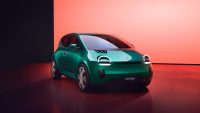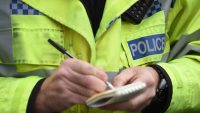New car sales in the UK dropped by nearly 16 per cent in April versus the year before, according to figures released by the SMMT this morning (May 5).
Registrations fell by 15.8 per cent to 119,167 units in April, with the industry body blaming global supply chain shortages – mainly of semiconductors – hampering new vehicle deliveries.
That was in spite of showrooms being open for the entire month, unlike in 2021 when lockdown restrictions were in place until April 12.
It said the decline was mainly driven by a 33.3 per cent decrease in large fleet registrations, as manufacturers continued prioritising private consumers because of robust demand.
That helped the latter market segment see an increase of 4.8 per cent, while smaller business registration volumes fared even better, growing by 15.4 per cent.
Battery-electric (BEV) registrations continued to grow with 12,899 of the latest zero-emission cars joining UK roads – an increase of 40.9 per cent on the same month last year – and taking a 10.8 per cent market share, which was up from 6.5 per cent last year.
While registrations of hybrids (HEVs) also rose by 18.3 per cent, the number of new plug-in hybrid (PHEV) registrations decreased by nearly a third (32.8 per cent). As a result, electrified vehicles comprised 27.9 per cent of all new car registrations during April.
The SMMT has now downgraded its forecast for the number of new cars expected to be sold this year by nine per cent to 1.72m – in January, it said 1.89m would be shifted.
Although that’s still a 4.5 per cent rise on 2021, the SMMT said it highlighted the effect the semiconductor shortage was still having on supply as well as anticipated impacts from rising living costs.
The outlook for plug-in vehicles was also downgraded, with the forecast for BEV registrations now at 289,000 units – down from 307,000 – with PHEVs at 144,000, which was down from 163,000.
HEVs also saw their outlook fall from 198,000 to 193,000.
This means that plug-in electric cars are now expected to account for a quarter of all registrations (25.2 per cent) during the year, with BEVs alone comprising around one in six new cars on the road.
Mike Hawes, SMMT chief executive, said today: ‘The worldwide semiconductor shortage continues to drag down the market, with global geopolitical issues threatening to undermine both supply and demand in the coming months.
‘Manufacturers are doing everything they can to deliver the latest low- and zero-emission vehicles, and those considering purchase should look to place their orders now to benefit from incentives, low interest rates and reduced running costs.
‘Accelerating the transformation of the new car market and the carbon savings demanded of road transport in such difficult times requires not just the resolution of supply issues, however, but a broader package of measures that encourages customer demand and addresses obstacles, the biggest of which remains charging anxiety.’
The Nissan Qashqai took the title of best-selling car in April with 3,804 registrations. It was followed by the Ford Puma (3,318), Mini (3,088), Vauxhall Corsa (3,002) and the Kia Sportage (2,407).
The Corsa remains the year-to-date top-seller with 12,799 registrations, followed by the Puma (11,947) and the Qashqai (11,335).
What the industry thinks
Chief hurdle is supply not demand
Despite a worsening cost-of-living crisis, consumer demand for new cars remains robust, with some vehicle manufacturers reporting many months’ worth of orders backing up.
But many of the sales reflected in April’s figures would have been concluded months ago and the chief hurdle to stronger growth remains supply, not demand. The supply chain issues and component shortages dogging the car industry are now likely to last into the first half of 2023 as the conflict in Ukraine exacerbates post-pandemic disruption for manufacturers.
Rocketing fuel prices are meanwhile pushing buyers towards electric vehicles from petrol and diesel cars in greater numbers. In the past month there’s been something of a landmark on our marketplace as the number of advert views for new alternatively fuelled vehicles briefly overtook petrol and diesel cars for the first time.
Ian Plummer, commercial director, Auto Trader
Consumers cannot carry burden of paying rising prices
While there are some positive trends in these figures, they offer little in the way of cheer: the automotive industry is in an increasingly precarious position which these latest numbers only serve to amplify.
On the one hand, the sector has successfully invested billions in creating desirable vehicles, including a raft of exciting new electrified models.
But on the other its output continues to be strangled by world events, most acutely from chip shortages that are now predicted to run into 2024 before being resolved, but increasingly from the war in Ukraine and its knock-on effects.
While profitability is high, the industry cannot expect to thrive in such a challenged market indefinitely – and likewise consumers cannot carry the burden of paying rising prices unchecked, especially as the cost of living elsewhere puts a focus on non-essential spending.
Jim Holder, editorial director, What Car?
Demand remains robust
As implications of conflict in the Ukraine further complicate supply chain challenges that were already lingering from the pandemic, the impact of a rising cost of living adds further uncertainty for the automotive industry in 2022.
Yet in the face of weakening consumer spending power and rising fuel and energy costs, car sales demand has remained relatively robust so far this year, compared with the very limited supply.
Spending intention also remains, with a fifth of consumers planning on spending savings in 2022 telling KPMG that they will use them to buy a car.
Richard Peberdy, UK head of automotive, KPMG
EVs are the only thing dealers can smile about
Dealers had hoped that the shackles would come off post-pandemic with increased demand helping to drive registrations, but supply issues (exacerbated by recent global events) mean their hands are still tied in the race to secure big ticket spend.
Electric is the only area where dealers have something to smile about, as many customers look to take advantage of incentives around the purchase of electric vehicles as part of an effort to manage wider pressures on household budgets.
Even with a growing order book, dealers in this sub-sector are still having to carefully manage supply – with semi-conductors a key area of focus.
Karen Johnson, head of retail & wholesale at Barclays Corporate Banking
Outlook remains mixed at best
After a painfully slow start to the year, things are getting worse for new car sales. April’s fall follows the worst March sales figures for nearly two and half decades, and the outlook remains mixed at best – thanks to the low numbers of new cars arriving in showrooms.
Dealers find it hard to sell cars they don’t yet have, and while determined buyers can place orders, many are being put off by wait times of weeks or even months.
With the global shortage of semiconductors impacting many overseas car plants too, the supply of new vehicles is struggling to keep up with customer demand.
That’s why we’re seeing a steady stream of prospective buyers switch their focus to the second-hand market, and many dealers report that sales of used vehicles are outpacing those of brand new models.
James Fairclough, chief executive officer, AA Cars
Industry coming to terms with ‘new normal’
With the start of the pandemic now over two years ago, we will continue to see the nearly new car pipeline hampered due to the production reductions limiting cars into the market from that time.
Despite the challenges facing the industry, the steady Q1 financial results demonstrate that the industry has come to terms with this ‘new normal’.
In the UK, EVs and battery manufacturing infrastructure continue to dominate conversations as the industry transitions to a future without internal combustion engines.
However, the UK automotive industry does require relief on energy costs equivalent to that afforded energy intensive industries and access to low cost and low carbon energy, comparable to European competitors to ensure it can grow and thrive.
Manu Varghese, UK & Ireland Advanced Manufacturing & Mobility Team, Ernst & Young LLP
More needs to be done to make EVs accessible for all
While new car sales overall continue to disappoint, once again it’s EVs that are providing the silver lining to the dark cloud that is hanging over the new car industry.
With prices at the pump continuing to soar for both new and older cars alike, EVs are becoming more attractive every day, so what the market needs now is for the government to up the ante in making EVs accessible for all.
Their recent announcement that EV charging points will be increased from 30,000 to 300,0000 in the next eight years will definitely help, but the sooner these can be rolled out to democratise EV ownership, the better.
Alex Buttle, co-founder, Motorway.co.uk
Brace yourselves for a fall in demand
The squeeze on consumer pockets has seen many households delay major purchases in an effort to save money. However, a divergence in consumer spending patterns is emerging; those with higher disposable incomes and savings accumulated over lockdown are still able to spend on new vehicles.
Although the sector continues to adapt to supply chain challenges – including the ongoing semi-conductor shortage – lead times are less of an issue this month for private sales as many dealers have been able to rely on stock ordered last year.
The cost of owning a car is rising, perpetuated by record-high fuel prices at the pumps. For those who lease their vehicles, car repayments already make up a major proportion of many consumers’ household bills.
The automotive sector must brace for a further fall in demand with just five per cent of consumers planning to purchase a car this quarter; a fall from seven per cent in Q4 2021. This decline will have wider-reaching implications for the sector as it could signify an end to the pent-up demand that was built up during the pandemic.
Jamie Hamilton, automotive director and head of electric vehicles, Deloitte


































